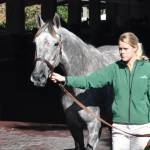Growth Management for Thoroughbred Foals in Japan

Foal owners and managers are often interested in growing the largest possible Thoroughbred yearlings because these young horses tend to bring the highest bids at yearling sales. However, because a number of factors are involved in foal growth rates, management and feeding practices that are successful in producing large, healthy foals in one country may not produce exactly the same results in other regions. Genetic makeup, pasture quality, prenatal broodmare nutrition, and other things may influence the growth rate, and pushing for unrealistic growth can cause skeletal problems.
At an equine nutrition conference hosted by Kentucky Equine Research, officials from the Japan Racing Association reported on problems that occurred when U.S.-based foal growth rate averages were used as goals for growth in Japan. When management steps promoted fast growth for Japanese foals based on average growth figures for foals raised in the U.S., the incidence of bone formation abnormalities also increased.
A study was conducted in which body weight, withers height, heart girth, and cannon bone circumference of approximately 270 foals of the Hidaka district in Japan were measured every two months from 1 to 15 months of age. The incidence of epiphysitis was monitored and the relationship to the dietary contents at weaning was studied. The body weight curve up to approximately six months of age was similar to data for horses with a 1,325 lb (600 kg) mature weight while between 6 and 15 months of age, the body weight curve flattened somewhat. The baseline body weight and withers height curves were similar to those of horses in Kentucky.
In this study, epiphysitis of the fetlock joint was observed in some foals from three to seven months of age. These foals weighed heavier at one month of age and their growth rates were more rapid than unaffected foals. Epiphysitis of the knee joint was observed in some foals at approximately 15 months of age. These foals weighed lighter while nursing, but were inclined to grow rapidly after weaning compared to unaffected foals. There were high correlations between the incidence of epiphysitis in fetlock joints after weaning and poor intakes of dietary copper, zinc, calcium, and protein at this stage of growth. These results suggested that it would be advantageous to develop different target growth rate figures for Thoroughbred foals raised in Japan.








